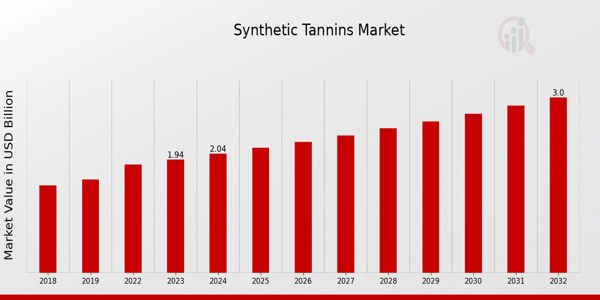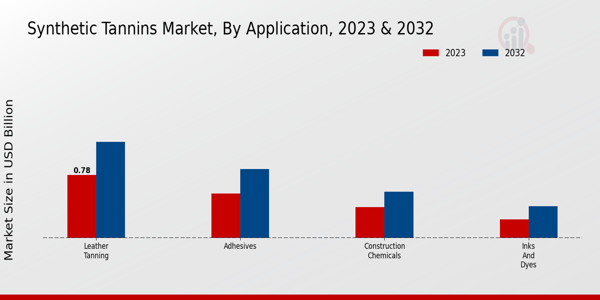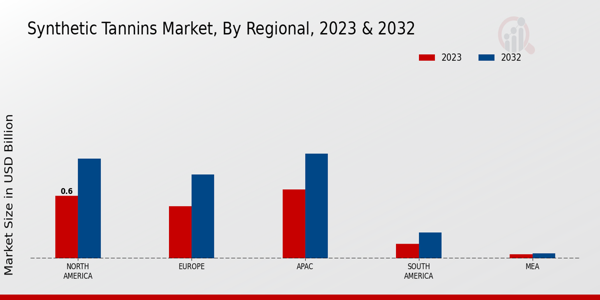Global Synthetic Tannins Market Overview
The Synthetic Tannins Market Size was estimated at 2.14 (USD Billion) in 2024. The Synthetic Tannins Industry is expected to grow from 2.24 (USD Billion) in 2025 to 3.47 (USD Billion) by 2034. The Synthetic Tannins Market CAGR (growth rate) is expected to be around 5.0% during the forecast period (2025 - 2034).
Key Synthetic Tannins Market Trends Highlighted
The Synthetic Tannins Market is influenced by several key drivers, particularly the increasing demand from various industries like leather, food and beverages, and pharmaceuticals. As consumers become more aware of the quality and sustainability of products, manufacturers are leaning towards synthetic tannins as a more eco-friendly option compared to traditional methods. The versatility of synthetic tannins, which can be tailored for different applications, has made them a preferred choice in many sectors. Additionally, the shift towards sustainable production practices is pushing industries to adopt more innovative alternatives, boosting the demand for synthetic options.The synthetic tannins market offers a number of prospects for investigation, particularly in the area of research and development. To address the growing environmental concerns, businesses can concentrate on developing bio-based tannins or improving the effectiveness of current solutions. By incorporating sustainable practices into their operations, firms may capitalize on the growing trend of eco-conscious consumerism and set themselves apart from the competition. Additionally, growing applications in cosmetics and textiles offer growth prospects that might not have been completely realized yet. Players in this sector might potentially gain a lot by entering new markets with fast industrial expansion.Recent trends highlight a shift toward customization and greater functionality in synthetic tannins, with a greater emphasis on quality and performance. Innovations in production processes aim to reduce the overall environmental footprint while meeting consumer demands for high-quality, sustainable products. Collaboration between manufacturers and research institutions is increasingly common, pushing the boundaries of what synthetic tannins can achieve across various applications. As technology progresses, it will likely open up even more pathways for growth, allowing market participants to adapt to evolving consumer preferences and regulatory requirements effectively.

Source: Primary Research, Secondary Research, MRFR Database and Analyst Review
Synthetic Tannins Market Drivers
Rising Demand for Eco-Friendly Products
The increasing global focus on sustainability and the demand for eco-friendly products are significant drivers of growth in the Synthetic Tannins Market Industry. As consumers become more environmentally conscious, manufacturers are pressured to develop products that are not only high-performing but also sustainable. Synthetic tannins are often derived from renewable resources and have a lower environmental impact compared to traditional tannins sourced from tree bark or other natural sources.This appeal to sustainability is influencing various industries, especially in leather production, textiles, and food and beverages, where synthetic tannins can replace harmful chemicals traditionally used in these processes. The shift towards eco-friendly and biodegradable alternatives is paving the way for a larger market share, encouraging innovation in the production methods of synthetic tannins. Furthermore, regulatory pressures from governments aimed at reducing carbon footprints have prompted many manufacturers to shift towards more sustainable practices, boosting growth within the Synthetic Tannins Market.As businesses aim for compliance with stringent environmental standards and laws, the adoption of synthetic tannins is projected to escalate, offering vast market potential. Additionally, the advancements in synthetic tannin formulations that enhance performance and reduce toxicity are aligning with global sustainability goals. This not only appeals to health-conscious consumers but also addresses concerns over the safety of conventional chemicals in various applications.
Growing Usage in Leather and Textile Industries
The leather and textile industries are significant consumers of synthetic tannins, which drive the Synthetic Tannins Market Industry. As these industries expand globally, the demand for synthetic tanning agents continues to increase, especially due to their efficiency and the high-quality results they deliver. Synthetic tannins provide excellent color, durability, and resistance to water and heat in leather products, making them highly desirable in both fashion and function.With the rising consumer demand for durable and high-performance leather goods, manufacturers in these sectors are increasingly turning to synthetic tannins to meet these expectations.
Innovations in Food and Beverage Preservation
The food and beverage sector is harnessing synthetic tannins for their antioxidant properties and preservation capabilities, which further propels the growth of the Synthetic Tannins Market Industry. As health consciousness rises, synthetic tannins are being recognized for their role in improving the stability and shelf life of products, which appeals to both manufacturers and consumers alike. The ability of synthetic tannins to reduce spoilage and enhance food quality is fostering innovation in preservation techniques, presenting new applications in the culinary world.
Synthetic Tannins Market Segment Insights
Synthetic Tannins Market Application Insights
The Synthetic Tannins Market is experiencing significant growth within the Application segment, which encompasses various industries such as Leather Tanning, Adhesives, Construction Chemicals, Inks, and Dyes. In 2023, the total market value stands at 1.94 USD Billion, with projections indicating an increase to 3.0 USD Billion by 2032. Among these applications, Leather Tanning captures a majority holding with a valuation of 0.78 USD Billion in 2023, which is expected to rise to 1.19 USD Billion in 2032. This segment's dominance can be attributed to the ongoing demand for high-quality leather products, which rely heavily on synthetic tannins for enhanced durability and functionality. Adhesives follow closely, valued at 0.55 USD Billion in 2023 and anticipated to reach 0.85 USD Billion by 2032. The growth in this segment is driven by the increasing requirement for versatile and strong bonding solutions in various industries, including construction and automotive, where synthetic tannins play a critical role in formulating effective adhesive products.The market for Construction Chemicals is also noteworthy, valued at 0.38 USD Billion in 2023, with prospects for growth to 0.57 USD Billion by 2032. As urbanization and infrastructure development accelerate globally, the need for advanced construction solutions is rising, positioning synthetic tannins as vital components in creating high-performance construction materials that enhance strength and durability.Lastly, the Inks and Dyes application constitutes a smaller yet important segment, with a valuation of 0.23 USD Billion in 2023, projected to grow to 0.39 USD Billion by 2032. Although this segment is currently the least dominant, the unique properties of synthetic tannins offer promising solutions for environmentally friendly and high-performance inks and dyes, which can contribute to sustainable practices in various industries.The overall trends in the Synthetic Tannins Market show that an expanding application range across diverse industries, driven by innovations and demand for sustainable products, highlights the growing importance of synthetic tannins. As various industries seek to improve product performance and environmental impact, the Applications segment within the Synthetic Tannins Market is expected to continue its upward trajectory, creating opportunities for companies to innovate and expand their market presence. With promising statistics and diverse applications, this segment remains a significant contributor to the overall market growth.

Source: Primary Research, Secondary Research, MRFR Database and Analyst Review
Synthetic Tannins Market Source Insights
The Synthetic Tannins Market is projected to achieve a valuation of 1.94 billion USD in 2023, with a strong focus on the Source segment. This segment consists of various types, such as Phenolic Tannins, Amino Tannins, Carbohydrate Tannins, and Synthetic Tannins, each contributing significantly to the market dynamics. Phenolic Tannins are noted for their applications in the leather industry and are recognized for their effectiveness in various formulations, making them an essential part of the market landscape. Amino Tannins, valued for their binding properties, play a crucial role in both nutritional and industrial applications.Carbohydrate Tannins, while often less prominent, are vital in certain specialized applications due to their unique characteristics. The overall market growth is driven by increasing demand across sectors, including leather, food, and beverage industries, alongside growing environmental concerns that favor the adoption of synthetic alternatives. However, challenges like regulatory hurdles and sourcing raw materials may pose barriers to growth. Nonetheless, the potential for innovation and expanding applications presents significant opportunities within the Synthetic Tannins Market, enhancing its overall viability and long-term market growth.
Synthetic Tannins Market End Use Industry Insights
The Synthetic Tannins Market has demonstrated substantial growth within the End Use Industry, valued at approximately 1.94 billion USD in 2023. This segment encompasses several vital industries, including automotive, footwear, furniture, and textiles, each contributing significantly to the market dynamics. The automotive sector benefits from synthetic tannins through enhanced durability and improved performance in-vehicle components. The footwear segment sees increased usage due to its ability to provide quality and comfort, while the furniture industry utilizes synthetic tannins for enhanced aesthetic appeal and longevity.Textile applications leverage synthetic tannins for their exceptional dyeing properties and ability to impart desirable textures. Overall, these industries shape the Synthetic Tannins Market revenue, which is set to experience notable growth, driven by increasing demand for eco-friendly materials and innovative applications across these sectors. The market statistics indicate opportunities for diversification and growth, with sustainable practices expected to further enhance raw material sourcing and program initiatives, making the synthetic tannins landscape increasingly competitive.
Synthetic Tannins Market Form Insights
The Synthetic Tannins Market is projected to reach a valuation of 1.94 billion USD by 2023, showcasing the steady demand across various forms, particularly in Liquid and Powder formats. The market reflects a diverse range of applications, which subsequently drives the need for different forms of synthetic tannins. Liquid forms are often preferred for their ease of use in industries like leather processing and cosmetics, providing efficiencies in production and formulation. Meanwhile, Powder formats hold a significant market share, primarily due to their versatility and effectiveness in applications such as food preservation and industrial applications.The combination of these forms plays a critical role in addressing the rising demand for sustainable and functional additives in multiple sectors, including pharmaceuticals and textiles. As the Synthetic Tannins Market continues to expand, the growing focus on environmental sustainability and eco-friendly products is anticipated to drive further innovation and market growth. The Synthetic Tannins Market data reflects an evolving landscape where both Liquid and Powder forms cater to an increasingly diverse range of consumer needs and industry requirements.
Synthetic Tannins Market Regional Insights
The Synthetic Tannins Market is experiencing notable growth across its regional segments, with a total market value expected to be 1.94 USD Billion in 2023. North America emerges as a key player with a market value of 0.6 USD Billion, projected to reach 0.95 USD Billion by 2032, reflecting significant demand driven by the leather and food industries. Europe follows closely, valued at 0.5 USD Billion in 2023 and expected to increase to 0.8 USD Billion, showcasing strong utilization in textile and pharmaceuticals. The Asia-Pacific (APAC) region holds a substantial share, starting at 0.66 USD Billion in 2023 and aiming for 1.0 USD Billion by 2032, highlighting its dominance in manufacturing and growing consumer markets.In South America, the market starts at 0.14 USD Billion with an estimated rise to 0.25 USD Billion, indicating potential growth opportunities, while the Middle East Africa (MEA) remains modest, with values of 0.04 USD Billion in 2023 and 0.05 USD Billion in 2032. Overall, this regional segmentation illustrates the diverse applications and market dynamics driving growth in the Synthetic Tannins Market, reflecting both established markets and emerging opportunities.

Source: Primary Research, Secondary Research, MRFR Database and Analyst Review
Synthetic Tannins Market Key Players and Competitive Insights
The competitive landscape of the Synthetic Tannins Market is characterized by diverse players striving to capture market share in a sector that continues to grow due to rising demands across various applications such as leather tanning, food, and beverages. This market exhibits a mix of well-established companies and emerging players, each bringing unique strengths and innovations to differentiate their offerings. Competition is driven by various factors, including product quality, technological advancements, production capabilities, and the growing trend toward sustainable practices. Furthermore, players are focusing on exploring new market opportunities in developing regions and increasing their investments in research and development to enhance their product lines and meet the specific needs of different industries.Kraton has established itself as a formidable player in the Synthetic Tannins Market, leveraging its extensive experience and technical expertise to develop high-quality synthetic tannins for various applications. The company’s strength lies in its innovative product portfolio, which includes a range of synthetic tannins that cater to the needs of leather manufacturers, food processing, and other industrial applications. Kraton's commitment to sustainability and eco-friendly practices earns them a competitive edge, as they prioritize the development of products that align with the growing demand for green solutions. Additionally, their strong distribution network allows them to efficiently reach global markets, further solidifying their position within the industry.Lenzing, an established name in the Synthetic Tannins Market, is also recognized for its commitment to quality and sustainability. The company focuses on producing eco-conscious products that leverage advanced technology in their synthetic tannin offerings. Lenzing stands out due to its emphasis on circular economy practices, which not only appeal to environmentally-aware consumers and businesses but also enhance the brand's reputation. Their significant research and development capabilities enable them to innovate continuously and improve their product offerings, making them a reliable choice for customers seeking high-performance synthetic tannins. With a robust market presence, Lenzing effectively competes by addressing the diverse needs of different sectors, leading to an increasing demand for their sustainable synthetic tannin solutions.
Key Companies in the Synthetic Tannins Market Include
- Kraton
- Lenzing
- Tannin Corporation
- Tanac
- Tannins and More
- Silvateam
- Tannase
- Aditya Birla Group
- BASF
- Ashland
- Tarrago
- Sappi
- DuPont
- Gubelin
Synthetic Tannins Market Industry Developments
Recent developments in the Synthetic Tannins Market have showcased significant advancements, especially with companies like Kraton and Lenzing actively enhancing their product lines and sustainability efforts. Tannin Corporation and Tanac have reported increased production capacities to meet the rising demand in various applications, particularly in the leather and textile industries. Meanwhile, Silvateam has introduced new eco-friendly synthetic tanning agents to cater to environmentally conscious consumers. Companies like Aditya Birla Group and BASF are investing heavily in research and development to innovate their synthetic tannin offerings. Recent acquisitions, including that of Ashland's strategic assets by another player in the market, highlight the ongoing consolidation trend within the industry as firms look to expand their market share and diversify their product portfolios. Sappi and DuPont are also focusing on enhancing their market valuation, which has shown positive trends and is believed to significantly impact overall industry growth. The landscape continues to evolve, influenced by consumer demand for sustainable practices and innovative solutions in the synthetic tannins space.
Synthetic Tannins Market Segmentation Insights
- Synthetic Tannins Market Application Outlook
- Leather Tanning
- Adhesives
- Construction Chemicals
- Inks and Dyes
- Synthetic Tannins Market Source Outlook
- Phenolic Tannins
- Amino Tannins
- Carbohydrate Tannins
- Synthetic Tannins
- Synthetic Tannins Market End Use Industry Outlook
- Automotive
- Footwear
- Furniture
- Textiles
- Synthetic Tannins Market Form Outlook
| Report Attribute/Metric |
Details |
| Market Size 2024 |
2.14 (USD Billion) |
| Market Size 2025 |
2.24 (USD Billion) |
| Market Size 2034 |
3.47 (USD Billion) |
| Compound Annual Growth Rate (CAGR) |
5.0% (2025 - 2034) |
| Report Coverage |
Revenue Forecast, Competitive Landscape, Growth Factors, and Trends |
| Base Year |
2024 |
| Market Forecast Period |
2025 - 2034 |
| Historical Data |
2020 - 2024 |
| Market Forecast Units |
USD Billion |
| Key Companies Profiled |
Kraton, Lenzing, Tannin Corporation, Tanac, Tannins and More, Silvateam, Tannase, Aditya Birla Group, BASF, Ashland, Tarrago, Sappi, DuPont, Gubelin |
| Segments Covered |
Application, Source, End Use Industry, Form, Regional |
| Key Market Opportunities |
Eco-friendly product demand surge, Rising leather industry growth, Expanding pharmaceuticals applications, Increased use in food beverages, Innovations in agricultural biochemicals |
| Key Market Dynamics |
rising leather production demand, increasing eco-friendly practices, growth in food beverage applications, innovations in pharmaceutical uses, expanding construction and automotive industries |
| Countries Covered |
North America, Europe, APAC, South America, MEA |
Frequently Asked Questions (FAQ) :
The Synthetic Tannins Market is expected to be valued at 3.47 billion USD by 2034.
The projected CAGR for the Synthetic Tannins Market from 2025 to 2034 is 5.0%.
The Leather Tanning application recorded the highest market value at 0.78 billion USD in 2024.
The Adhesives application is expected to be valued at 0.85 billion USD by 2034.
North America accounted for a market share valued at 0.6 billion USD in 2024.
The Synthetic Tannins Market in the APAC region is expected to be valued at 1.0 billion USD by 2034.
Key players in the Synthetic Tannins Market include Kraton, Lenzing, and BASF.
The market value for Construction Chemicals in 2034 is projected to be 0.57 billion USD.
The estimated market value for Inks and Dyes by 2034 is 0.39 billion USD.
The expected market size for South America in the Synthetic Tannins Market by 2034 is 0.25 billion USD.

















